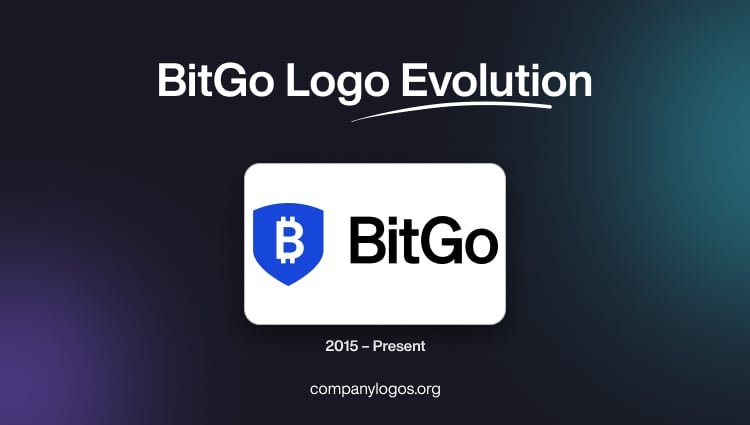
BitGo is the leading digital asset infrastructure company that provides comprehensive financial services and security solutions for the rapidly evolving cryptocurrency ecosystem. It was founded in 2013 by Mike Belshe and Ben Davenport and is based in Palo Alto, California. Over the years, BitGo has established itself as the trusted operational backbone for thousands of institutional clients worldwide. It manages over $100 billion in assets under custody as of 2025.
The visual identity of BitGo has witnessed the journey of the company from a technical startup (multi-signature wallets) to a broad institutional digital-asset custodian. The logo has evolved into a compact, security-forward badge that pairs a shield with a custom Bitcoin/₿ element to signal institutional trust and crypto focus. The article delves into the BitGo logo and its evolution, among other details of the company.
The Genesis of the BitGo Logo (2013) (Unavailable)
The early BitGo visual identity is not available in the public domain. However, it is assumed to consist of a wordmark in blue. The one that is visible across platforms today is the one introduced in 2015.
(2015 – Present)
The BitGo logo that we know today was arguably introduced in 2015. It featured a compact logomark, that is, a shield containing a custom, modified Bitcoin “₿” glyph in blue. The letter “B” is a stylised version of the Bitcoin symbol and it anchors the brand identity of BitGo as a cryptocurrency security company. The shield with a blue background highlights the letter “B” in white for better contrast and visual acuity.
The shield emblem symbolises enhanced security, trust, and institutional grade protection in the world of cryptocurrency. To its right is mentioned the BitGo wordmark in black using a Sohne in Kraftig weight typeface. The letters in black against a white background combine a mix of uppercase and lowercase.

The Elements of the BitGo Logo
Symbol
The protective shield emblem remains central to the design, and it continues to symbolise security, trust, and institutional-grade protection.
Font
The wordmark in the BitGo logo has been written using the Söhne in Kraftig weight font. The font is characterised by modern, clean lettering that balances approachability with professional credibility.
Colour
The BitGo logo is designed using a sophisticated blue colour scheme that conveys trust, stability, and technological innovation.
The History of BitGo
BitGo was founded in 2013 by Mike Belshe (an early internet engineer who co-founded Lookout Software, which was later acquired by Microsoft) and Ben Davenport (a software engineer and investor). The company was born in the wake of Bitcoin’s growing popularity. During that time the founders recognised the pressing need for better security solutions for digital assets.
At that time, cryptocurrency thefts and exchange hacks were rampant, and most wallets relied on single-key access, which left funds vulnerable. To solve this, BitGo introduced multi-signature (multi-sig) wallets containing three keys – one held by the user, one held by BitGo, and one as a backup key. This innovation significantly reduced the risk of theft or loss, as no single entity had complete control over the funds.
With the acceleration of the adoption of cryptocurrency, BitGo became a trusted provider of institutional-grade wallet security. Its multi-sig solution gained traction among exchanges, custodians, and businesses that handled large amounts of Bitcoin. In 2015, BitGo launched its APIs that allowed businesses to integrate secure Bitcoin transactions into their platforms. Around this time, the company also began expanding beyond Bitcoin to support multiple digital assets. It aligned with the broader growth of the crypto ecosystem.
BitGo’s focus on compliance and security helped it attract clients that needed more than just a software wallet. It positioned itself as a critical infrastructure provider for institutional investors. In 2018, BitGo made a major leap forward by launching BitGo Trust Company, which was the first qualified custodian purpose-built for digital assets. This move came in response to the demand of institutional investors for regulated, secure storage solutions that met legal and compliance requirements.
In the same year, BitGo acquired Kingdom Trust’s South Dakota trust company charter, which enabled it to operate under U.S. financial regulations. This marked a turning point, as BitGo was no longer just a technology company but also a regulated financial entity. In 2019, BitGo announced that it was processing 20% of all global Bitcoin transactions. This underlined its importance to the crypto ecosystem. It also introduced services such as insurance for digital assets, thereby further reassuring institutions about the safety of their holdings.
During the early 2020s, BitGo broadened its offerings to cover the full spectrum of institutional needs in crypto. These included trading and lending services, settlement solutions, and portfolio and compliance tools. In 2021, BitGo briefly entered acquisition talks with Galaxy Digital, the crypto merchant bank founded by Mike Novogratz. Galaxy announced plans to acquire BitGo for $1.2 billion, but the deal ultimately fell through in 2022. Despite this, BitGo continued to expand independently.
By this period, BitGo had grown into one of the largest custodians of digital assets in the world. It served exchanges, institutional investors, and funds across multiple jurisdictions. In 2023, BitGo raised $100 million in a Series C funding round, which valued the company at $1.75 billion. The funds were directed toward expanding global custody, settlement, and wallet infrastructure.
BitGo also continued to strengthen its regulatory presence. In doing so, it obtained trust licences and approvals in various jurisdictions to better serve international clients. Its focus shifted increasingly toward being a comprehensive financial services provider for digital assets. It went on to cover custody, settlement, staking, compliance, and liquidity services. BitGo is recognised as one of the leading institutional custodians in the digital asset space. It offers top-notch security solutions to hedge funds, family offices, banks, and crypto-native firms worldwide.
Interesting Facts About BitGo
- BitGo was the first company to implement multi-signature (multi-sig) wallets for Bitcoin. This was a breakthrough innovation in 2013 that greatly improved security in the crypto world.
- At one point, BitGo was responsible for processing about 20% of all global Bitcoin transactions, which made it one of the most important players in the Bitcoin ecosystem.
- In 2018, BitGo launched the BitGo Trust Company and became the first regulated custodian built specifically for cryptocurrencies. This gave institutions the confidence to invest in digital assets while remaining compliant with regulations.
- BitGo was among the first to offer insurance coverage (up to $100 million) for digital assets held in custody. It was an unprecedented step at the time to boost institutional trust in crypto.
- In 2021, Galaxy Digital announced it would acquire BitGo for $1.2 billion, which would have been one of the largest deals in the crypto industry. The acquisition, however, fell through in 2022, and BitGo remained independent.
- While it started with Bitcoin, BitGo’s custody and wallet infrastructure now supports over 600 tokens across 50+ blockchains. It caters to the diverse needs of the crypto market.
- In 2023, BitGo raised $100 million in Series C funding, which pushed its valuation to $1.75 billion.
- BitGo counts among its clients crypto exchanges, hedge funds, family offices, banks, and fintechs.
- BitGo is based in Palo Alto, California, at the heart of Silicon Valley, which underscores its technology-driven DNA while operating within a global financial context.
- Through its innovations and regulatory initiatives, BitGo has helped shape what is now considered the industry standard for crypto custody and security practices.
Finally
The evolution of the BitGo logo chronicles the maturation of both the company and the broader cryptocurrency industry. From a startup wallet provider to a $1.75 billion digital asset infrastructure company processing $100 billion in custody assets, BitGo’s visual identity has successfully adapted while maintaining its core message of security and trust.